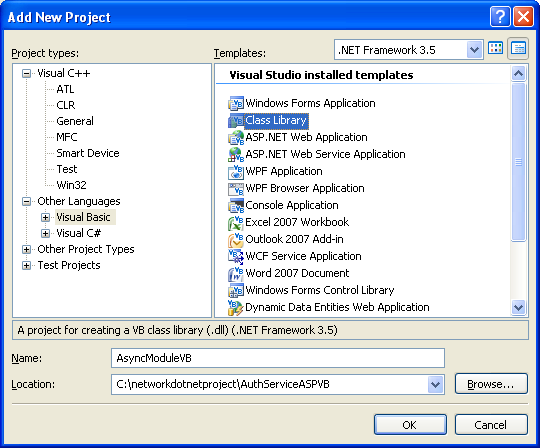How To Create A Module In Visual Basic
Adding New VB .NET ModuleAt this stage we already completed the VB .NET web service project. Next, let add another project for the asynchronous web access. Add a new project. Select Class Library project template and you can use AsyncModuleVB as the project name. |
Change the default given class name to AsyncModule to reflect the application to be developed.
Imports System
Imports System.Web
Imports System.Threading
Imports System.Text.RegularExpressions
Public Class AsyncModule
Implements IHttpModule
' shared data members
Shared counter As Integer = 0
Shared modCounter As Integer = 0
Const RedirectLocation As String = "accessdenied.aspx"
' instance data members
Dim instanceCounter As Integer
Dim isAuthorized As Boolean
Dim ctx As HttpContext
Dim locationRegex As Regex = New Regex(RedirectLocation, RegexOptions.IgnoreCase)
Public Sub Dispose() Implements IHttpModule.Dispose
' nothing to do
End Sub
Public Sub Init( ByVal app As HttpApplication) Implements IHttpModule.Init
' register for our async event
app.AddOnAuthorizeRequestAsync( New BeginEventHandler( AddressOf AsyncBeginHandler), New EndEventHandler( AddressOf AsyncEndHandler))
' add a sync EndRequest handler to explain what happened if
' access is denied
AddHandler app.EndRequest, New EventHandler( AddressOf OnEndRequest)
Dim modCount As Integer = Interlocked.Increment(modCounter)
TraceHelper.WriteLine( "AsyncModule.Init: Initializing the module instance..." , modCount)
End Sub
Public Function AsyncBeginHandler( ByVal src As Object , ByVal e As EventArgs, ByVal cb As AsyncCallback, ByVal extraData As Object ) As IAsyncResult
Dim app As HttpApplication = CType (src, HttpApplication)
' per-request init
instanceCounter = Interlocked.Increment(counter)
isAuthorized = False
ctx = app.Context
' let anyone into the access denied page
Dim m As Match = locationRegex.Match(ctx.Request.FilePath)
' is it something other than accessdenied.aspx? Check authorization...
If Not m.Success Then
' create service proxy, async result, and callback
Dim authServ As New AuthorizationService.Service1
Dim myAr As MyAsyncResult = New MyAsyncResult(cb, authServ, instanceCounter)
Dim myCb As New AsyncCallback( AddressOf WebServiceAsyncCallback)
' start async call
TraceHelper.WriteLine( "AsyncModule.AsyncBeginHandler: Begin the authorization..." , instanceCounter)
authServ.BeginIsAuthorized(ctx.User.Identity.Name, myCb, myAr)
Return myAr
' otherwise, complete synchronously
Else
isAuthorized = True
TraceHelper.WriteLine( "AsyncModule.AsyncBeginHandler: Request for accessdenied.aspx page, skipping..." , instanceCounter)
Return New MyAsyncResult( Nothing , Nothing , True , True , Nothing , instanceCounter)
End If
End Function
Public Sub AsyncEndHandler( ByVal ar As IAsyncResult)
Dim myAr As MyAsyncResult = CType (ar, MyAsyncResult)
TraceHelper.WriteLine( "AsyncModule.AsyncEndHandler: Ending the authorization..." , instanceCounter)
' if this user isn't authorized, then bail out
If Not isAuthorized Then
ctx.Response.StatusCode = 403
ctx.ApplicationInstance.CompleteRequest()
TraceHelper.WriteLine( "AsyncModule.AsyncEndHandler: Request Rejected..." , instanceCounter)
End If
' clear variables
ctx = Nothing
instanceCounter = -1
isAuthorized = False
myAr.EndOp() ' throw if necessary
End Sub
Public Sub WebServiceAsyncCallback( ByVal ar As IAsyncResult)
Dim myAr As MyAsyncResult = CType (ar.AsyncState, MyAsyncResult)
Dim authServ As AuthorizationService.Service1 = CType (myAr.AsyncState, AuthorizationService.Service1)
' get back result
isAuthorized = authServ.EndIsAuthorized(ar)
TraceHelper.WriteLine( "AsyncModule.WebServiceAsyncCallback: WebService call completed..." , instanceCounter)
' tell ASP.NET we're done
Dim cnt As Integer = instanceCounter
TraceHelper.WriteLine( "AsyncModule.WebServiceAsyncCallback: Begin notifing ASP.NET..." , cnt)
myAr.Complete( False , isAuthorized, Nothing )
TraceHelper.WriteLine( "AsyncModule.WebServiceAsyncCallback: End notifing ASP.NET..." , cnt)
End Sub
Public Sub OnEndRequest( ByVal src As Object , ByVal E As EventArgs)
Dim app As HttpApplication = CType (src, HttpApplication)
' did we block someone?
If app.Response.StatusCode = 403 Then
app.Response.Redirect(RedirectLocation, False )
End If
End Sub
End Class
You can use the MyAsyncResult as the module name.
Add/edit the code as shown below. This code implements the IAsyncResult interface.
Imports System
Imports System.Threading
Imports System.Diagnostics
' Implementation of IAsyncResult
Public Class MyAsyncResult
Implements IAsyncResult
' data members
Dim cb As AsyncCallback
Dim state As Object
Dim completed As Boolean
Dim completedSync As Boolean
Dim result As Object
Dim err As Exception
Dim counter As Integer
Public Sub New ( ByVal callb As AsyncCallback, ByVal st As Object , ByVal cnt As Integer )
Me .cb = callb
Me .state = st
Me .counter = cnt
End Sub
' constructor with predefined results,
' useful for errors that occur before async work is done
Public Sub New ( ByVal callb As AsyncCallback, ByVal st As Object , ByVal complete As Boolean , ByVal res As Object , ByVal e As Exception, ByVal cnt As Integer )
Me .cb = callb
Me .state = st
Me .completed = complete
Me .completedSync = Me .completed
Me .result = res
Me .err = e
Me .counter = cnt
If Not IsNothing(cb) Then
cb( Me )
End If
If Me .completed Then
TraceHelper.WriteLine( "MyAsyncResult.New: MyAsyncResult completed sync" , counter)
End If
End Sub
Public ReadOnly Property AsyncState() As Object Implements System.IAsyncResult.AsyncState
Get
Return state
End Get
End Property
Public ReadOnly Property AsyncWaitHandle() As System.Threading.WaitHandle Implements System.IAsyncResult.AsyncWaitHandle
Get
Return Nothing ' Wait not Supported
End Get
End Property
Public ReadOnly Property CompletedSynchronously() As Boolean Implements System.IAsyncResult.CompletedSynchronously
Get
Return completedSync
End Get
End Property
Public ReadOnly Property IsCompleted() As Boolean Implements System.IAsyncResult.IsCompleted
Get
Return completed
End Get
End Property
' non IAsyncResult Stuff
Public ReadOnly Property AsyncError() As Exception
Get
Return err
End Get
End Property
Public Sub Complete( ByVal sync As Boolean , ByVal res As Object , ByVal e As Exception)
TraceHelper.WriteLine( "MyAsyncResult.Complete: MyAsyncResult.Complete called" , counter)
completed = True
completedSync = sync
result = res
err = e
If Not IsNothing(cb) Then
cb( Me )
End If
End Sub
Public Function EndOp() As Object
If Not IsNothing(err) Then
Throw New Exception( "AsyncOperation failed" , err)
End If
Return result
End Function
End Class
Next, add the helper class that will dump messages. You can use TraceHelper as the class name.
Add/edit the code as given below. This code just printing a message related to the asynchronous operations.
Imports System
Imports System.Threading
Imports System.Diagnostics
Public Class TraceHelper
Public Shared Sub WriteLine( ByVal msg As String , ByVal cnt As Integer )
Dim tid As Integer = Thread.CurrentThread.ManagedThreadId
Trace.WriteLine( String .Format( "TraceHelper.WriteLine: ThreadId: {0} Counter: {1} Msg: {2}" , tid, cnt, msg))
End Sub
End Class
How To Create A Module In Visual Basic
Source: https://www.winsocketdotnetworkprogramming.com/xmlwebservicesaspnetworkprogramming11l.html
Posted by: johnsonbefteeprishe.blogspot.com




0 Response to "How To Create A Module In Visual Basic"
Post a Comment